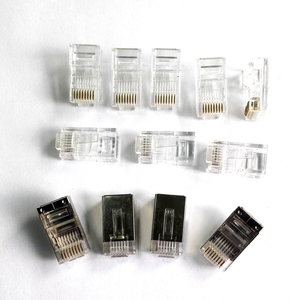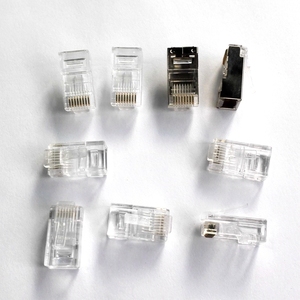Types
RJ11 double connectors are used mainly for telephone wiring. A double socket will connect two RJ11 cables, allowing signals to be transmitted across paths A and B. Various types, depending on the number of pairs required, are available here:
Single-Pair Socket
An RJ11 single pair double socket has only one pair of slots. A single RJ11 cable may thus be plugged into two operative interfaces. This kind is relatively uncommon because one telephone line requires only a single connection.
Two-Pair Socket
Two RJ11 telephone cables can be connected using a dual RJ11 connector, one cable per slot. A double pair socket comprises four slots or pins, one for each wire in the two pairs interconnected. This connector is ideal for low-strength applications that require two simultaneous phone lines.
Four-Pair Socket
The four pair sockets are designed for larger projects where many phone signals require running. A single four-pair RJ11 double connector will carry eight wires through four pairs of signal channels. Every business setting needing multiple extensions and complex telephone systems would benefit from this configuration.
Inline Coupler
There is another RJ11 double adapter category: the inline coupler. It is not a direct connector but plugs two RJ11 cables together with the integrated double jack function. In telco wiring, inline couplers are normally used to extend existing cabling.
Function, Feature, and Usage
Function
The main function of an RJ11 double connector is a simple connecting interface – bridging two phone lines, easy expansion of wiring systems, or connecting multiple devices through a single output. This versatility makes it essential for home and office phone setups that are reliable and efficient.
Features
Certain noteworthy features increase functionality and attractiveness:
- Easy Installation: RJ11 double jacks/sockets are plug-and-play devices that require additional tools or technical expertise to install.
- Cost-Efficient: RJ11 double connectors are easier to set up than new wiring systems or other switching devices.
- Compact Design: Because of their small profile, they can be fitted into everyday office equipment such as phones, modems, or fax machines.
- Durability: Most telephone connectors are made from highly resistant plastics or metals for continuous use.
Commercial Uses
Businesses and offices where telecommunication is heavy use RJ11 double connectors. Common applications are:
- Telephone Systems: The spacer double socket connects two RJ11 lines in a simple two-line office phone system.
- Modems and Routers: Internet was March 4, 1996 over a modem or router using a dual RJ11 connector to provide DSL or dial-up service.
- Fax Machines: Fax machines require dual lines in busy offices, so a double socket is convenient for fax machines.
- Intercoms: Intercom systems need multiple telephone signals. Four-pair double connectors fit well here.
- Extension Wiring: Additional extensions can be accommodated without adding wiring. Simple plug-in is used.
How to Choose
The following strategies will help when selecting an RJ11 double connector:
- Line Needs: Choose the connector based on the telephone lines needed. A single pair needs only a one-pair socket. If two lines, go for the dual pair. A complex system requires a four-pair connector.
- Device Compatibility: Check the existing network so that the connector fits. It includes phones, modems, or office systems. Verify that no adapter is needed here.
- Cabling Standards: Ensure the double connector complies with an in-house telephone wiring standard. Non-compliance degrades performance. RJ11 connectors have different pin configurations. Four-pair connectors will need more effort in management than fewer pair configurations.
- Office Density: More hardware in a busy workspace demands a compact, space-saving design. In contrast, more extended hardware needs an easy-to-access interface.
- Material Quality: A sturdy RJ11 double connector is needed for long-term, regular use. Look for quality metals or heavy plastics to ensure continuous operation and greater strength.
- Ease of Use: Some double connectors have integrated systems needing extra components. Such plug-and-play devices are easier.
Scenarios and Installation
Scenario 1: Office Telephone System
This office relies on several telephone lines to meet business communication demands. Using an RJ11 double connector of the two-pair type, one line will be run through the office, with another for conference rooms and executives. Only one pair of cable runs in this case. A dual connector will suffice without additional wiring.
Scenario 2: Home with Multiple Lines
If another thousand feet of telephone wire are laid across four pairs for a large mansion, four pair RJ11 connections will be needed. The phone call will be effective and efficient without wedging in additional wires. The whole household can use several lines.
Scenario 3: Intercom Installation
Strong Connectivity is needed for busy office intercom systems. An RJ11 four-pair double connector will ensure seamless signal transfer will suffice in this instance. All phone signals will pass through without interfering with regular operations.
Steps for Installing an RJ11 Double Connector
- Gather Tools: Get the double RJ11 socket ready by having an RJ11 crimping tool and wiring plan.
- Prepare the Cable: Strip a little insulation off the end of each RJ11 wire to expose the pairs.
- Arrange the Wires: According to the wiring plan, arrange the wires from left to right.
- Insert Wires: Put the arranged wires into the appropriate slots of the double connector.
- Crimp the Connector: Tighten using an RJ11 crimping tool to attach wires firmly to the jack.
- Test the Connection: After installation, check for correct wire continuity and signal on connected devices by using a cable tester.
Q&A
Q1: What does an RJ11 double connector do?
A1: The RJ11 double connector links two telephone lines through a single interface.
Q2: Where is an RJ11 double adapter used?
A2: Offices with multiple phone lines and home intercoms and fax machines are common places for the device.
Q3: How does an RJ11 double connector differ from a single connector?
A3: The single connector accommodates one line, while the double connector supports two concurrently.
Q4: Is installation complex for an RJ11 double connector?
A4: No, it is easy and straightforward, quite similar to ordinary plug-and-play devices.
Q5: Are double connectors compatible with DSL?
A5: Yes, they serve to connect devices over DSL or dial-up Internet.









































































































































































































